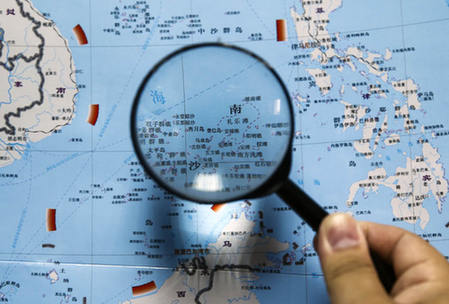Prospects for China-ASEAN Relations
By DONG CHUNLING
Territorial disputes in the South China Sea between China and ASEAN countries such as Vietnam and the Philippines notwithstanding, China-ASEAN relations remain very much on the track of peaceful development, mutual-benefit, and win-win cooperation. China recently raised new proposals on handling tensions in the South China Sea, so further diminishing possibilities that the issue may obstruct China and ASEAN member nations’ advance towards economic and strategic cooperation. The U.S. is hence unlikely to achieve its goal of containing China, fragmenting ASEAN, and interfering in East Asian integration.
|
 |
|
The South China Sea on the vertical atlas of China published last June. |
U.S. Intentions
Disputes between China and some of its neighbors over certain islands in the South China Sea are a long-standing issue. China has made clear its stance: it will not cede sovereignty but is willing to shelve differences and conduct joint development of the disputed region with other concerned parties. From the 1970s onward for an extended period, the issue never became heated. Although contentions arose every now and then they were resolved through diplomatic measures, and the situation in the South China Sea remained largely stable.
After its high-profile return to the Asia-Pacific region in 2009, the U.S. accelerated military deployments and increased diplomatic input in the region. Since 2010 there has occurred a rapid succession of antagonistic events, including the sinking of the ROK’s Cheonan and spats over the Diaoyu Islands. By hyping these incidents and holding frequent military maneuvers, South Korea and Japan have tilted towards the U.S., and relations between China and Vietnam and between China and the Philippines have become strained. Catch phrases associated with the East Asia situation are consequently changing from “economy, cooperation, and win-win” to “security, suspicion, and zero-sum.” Moreover, the U.S.-led Asia-Pacific alliance, a Cold War legacy, is predominant in the American version of regional economic integration, wherein the U.S. intends to replace the 10+3 (10 member countries of the ASEAN plus China, Japan and the Republic of Korea) mechanism and the free trade zone mechanism between China, Japan and ROK with its Trans-Pacific Partnership Agreement (TPP). It will thus absorb the East Asia integration process into a U.S.-dominated framework.
In addition to disrupting East Asia integration, the U.S. also sets out to contain China’s peaceful rise by using the South China Sea issue to hype the so-called “China Threat.” By playing on historical issues in the region the U.S. stokes tension between China and some of its neighbors, utilizing the ensuing confusion to generate distorted international perceptions of China’s justified defense of its sovereignty and legitimate rights and interests. The U.S. thus smears China’s image of peaceful development by sowing misgivings throughout the international community about the country’s development path, so scuttling regional cooperation with China.
The U.S. is using the South China Sea issue to lure ASEAN off the course of cooperation with China. Its whipping up of confrontations between China and Vietnam and between China and the Philippines has sent Sino-Vietnam and Sino-Philippines ties plummeting to rock bottom. Anti-China sentiment has infiltrated all corners of society in both countries. There have been multiple instances of shootings of Chinese citizens in the Philippines, and massive anti-China riots have erupted in Vietnam. The U.S. is now doing all it can to help the two countries succeed in their claims through a joint statement from ASEAN. The aim is to spread anti-China sentiment emanating from the two countries throughout the multi-lateral platform. Divisions over relations with China are already apparent among ASEAN member nations. This signifies that the organization is fragmenting and that its interests have been abducted, so inhibiting its further cooperation with China.

